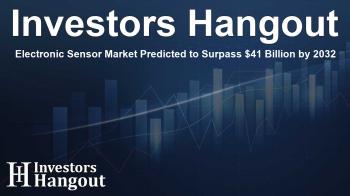Electronic Sensor Market Predicted to Surpass $41 Billion by 2032

Electronic Sensor Market Growth Forecast
The global electronic sensor market is experiencing remarkable growth, projected to achieve a staggering USD 41,221.48 million by 2032, growing at a compound annual growth rate (CAGR) of 6.65%. This expansion underscores the increasing integration of sensors across various sectors, from consumer electronics to industrial automation and healthcare technologies.
Role of Electronic Sensors in Modern Technology
Electronic sensors are the backbone of modern technology, enabling devices to convert physical phenomena such as light, heat, and motion into electrical signals interpretable by machines. As digital transformation accelerates in diverse industries, sensors have become indispensable, facilitating data-driven decision-making. The rise of the Internet of Things (IoT), advanced driver-assistance systems (ADAS), and interactive consumer products are key factors driving market growth.
The Driving Forces Behind Market Growth
Several critical factors are contributing to the robust growth of the electronic sensor market:
- IoT and Connected Devices: The rapid proliferation of IoT devices requires various sensors to gather environmental data, leading to unprecedented demand.
- Innovations in Automotive Technology: The automotive industry's shift toward electric and autonomous vehicles necessitates sophisticated sensor systems for operational safety and efficiency.
- Advancements in MEMS Technology: Micro-Electro-Mechanical Systems (MEMS) advancements are facilitating the production of small, cost-effective sensors that can be integrated into numerous devices.
Challenges Facing the Market
Despite the positive outlook, the electronic sensor market faces several challenges:
- Price Competition: With many electronic sensors being commoditized, manufacturers are under pressure to keep costs low, impacting profit margins.
- System Integration Complexity: The integration of sensors from different manufacturers can be complex and may deter companies from adopting new technologies.
- Supply Chain Issues: The reliance on a global supply chain for raw materials makes the sensor market susceptible to disruptions, affecting production and costs.
Emerging Trends in the Sensor Market
Several trends are shaping the future of the electronic sensor market:
- Smart Sensors: The evolution of sensors into smart devices capable of processing data on-site is revolutionizing applications in fields such as autonomous vehicles and industrial automation.
- Biodegradable Sensors: The focus on sustainability is leading to the development of flexible, biodegradable sensors that can minimize electronic waste.
- Sensor Fusion: The combination of inputs from multiple sensor types allows for more accurate and reliable data, essential for applications in autonomous driving and advanced robotics.
Opportunities in Key Sectors
Several sectors are poised to benefit significantly from this growth:
- Healthcare: The rising demand for telehealth and remote patient monitoring drives the need for specialized sensors capable of continuous health tracking.
- Agriculture: Innovative sensor deployment in precision farming can optimize resource use and enhance crop yields, addressing food supply challenges.
- Smart Cities: Investments in smart city initiatives create ample opportunities for sensor deployment across various urban infrastructure projects.
The Competitive Landscape
The electronic sensor market is characterized by competition among established players and emerging startups. Companies like Texas Instruments, Honeywell International, STMicroelectronics, and Bosch Sensortec are at the forefront, continuously innovating to enhance sensor performance and applications.
Frequently Asked Questions
What is the expected growth rate of the electronic sensor market?
The electronic sensor market is expected to grow at a CAGR of 6.65% and reach USD 41,221.48 million by 2032.
What are the main applications of electronic sensors?
Electronic sensors are widely used in automotive, healthcare, consumer electronics, and industrial automation applications.
What challenges does the electronic sensor market face?
Challenges include intense price pressure, complexity in system integration, and supply chain vulnerabilities.
What trends are influencing the electronic sensor market?
Key trends include the rise of smart sensors, the development of biodegradable sensors, and sensor fusion technology.
Which sectors are driving demand for electronic sensors?
The healthcare, agriculture, and smart city sectors are key drivers of demand for electronic sensors.
About The Author
Contact Olivia Taylor privately here. Or send an email with ATTN: Olivia Taylor as the subject to contact@investorshangout.com.
About Investors Hangout
Investors Hangout is a leading online stock forum for financial discussion and learning, offering a wide range of free tools and resources. It draws in traders of all levels, who exchange market knowledge, investigate trading tactics, and keep an eye on industry developments in real time. Featuring financial articles, stock message boards, quotes, charts, company profiles, and live news updates. Through cooperative learning and a wealth of informational resources, it helps users from novices creating their first portfolios to experts honing their techniques. Join Investors Hangout today: https://investorshangout.com/
The content of this article is based on factual, publicly available information and does not represent legal, financial, or investment advice. Investors Hangout does not offer financial advice, and the author is not a licensed financial advisor. Consult a qualified advisor before making any financial or investment decisions based on this article. This article should not be considered advice to purchase, sell, or hold any securities or other investments. If any of the material provided here is inaccurate, please contact us for corrections.

